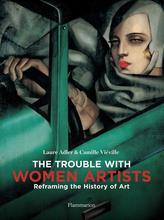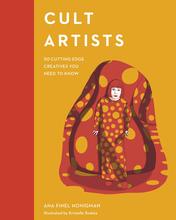More about Niki de Saint Phalle
- All
- Info
- Shop
Works by Niki de Saint Phalle

Contributor
Niki de Saint Phalle broke into the art world wielding a rifle.
Truthfully, there’s not a single moment of this incredible woman’s life that isn’t worth telling. As a child, Saint Phalle grew up in an aristocratic Catholic family, and spent much of her school life painting the fig leaves that covered the genitals of her school’s statues red. When she was at home, she could often be found playing games with her brother John pretending to be Hitler (penciled mustache and all)—not to mention their attic being painted with swastikas and consequently nosy neighbors suspecting their mother of being a Nazi sympathizer. You know, just your average suburban drama.
Saint Phalle eloped with her childhood friend Harry Mathews to France when she was eighteen. With little money, the two of them often shoplifted books and “luxurious foods” in order to maintain their aspired fancy French lifestyles. She gave birth to a daughter when she was 20 and quickly found motherhood and household responsibilities unsuitable (she once called laundry “too boring”). She and Mathews would often leave their daughter alone in her crib for hours at a time to go on long walks, but thankfully they thought to leave pieces of salami along the edges of the crib in case she ever woke up and got hungry. Such domestic bliss culminated with Saint Phalle having a nervous breakdown; she found out her husband was having an affair and took an entire bottle of sleeping pills which, amazingly, due to her mania, had no effect. After that, she was hospitalized in Nice and received ten rounds of electroshock therapy.
All of this, mind you, before she became an artist.
While in the clinic, she began painting as a form of therapy and discovered a profound affinity for it. Soon after she was released, she decided to pursue art with total dedication and promptly left her husband and children behind. To complement the act symbolically, she began her Tirs paintings, works that represented patriarchal roles she was expected to assume made with plaster and household items, which she then shot point blank with a rifle. If there’s a harsher way of telling your husband and kids you don’t want to be around them anymore, I haven’t heard it.
From then on, everything Saint Phalle did was in the name of rebellion and deconstruction of societal conventions. She became associated with the Nouveau Réalisme movement led by a group of artists with ideas similar to Saint Phalle’s. In the mid ‘60s, inspired by a pregnant wife, Saint Phalle began working on her Nanas series (“Nana” is a rude term for women, similar to “broad” in the US). The Nanas were bulbous, colorful, cartoonish sculptures with small heads and huge hips and breasts meant to depict the archetypal maternal figure. She started making them bigger and bigger—to the size of houses and buildings—claiming her intent was “so that men could look very small next to them.”
Despite her radical approach to her work, she rejected the term “feminist” and refused to appear in any exhibitions with only women artists. Men played a large role in her career as collaborators, supporters, and even partial funders of her projects. She once admitted that she realized at an early age she had “quite a bit of success with men” and learned to use that to her advantage. This isn’t to say she didn’t largely fund her own work. When she was in need of money, she simply started her own line of perfume on the side (you know, like any reasonable person would do) and sold inflatable Nanas as pool toys. Saint Phalle was a true entrepreneur and sought to manifest her artistic visions, no matter the cost.
Sources
- The Art Story Editors. “Niki de Saint Phalle.” www.theartstory.com. Accessed November 15, 2017. http://www.theartstory.org/artist-de-saint-phalle-niki.htm.
- Johnson, Ken. “Niki de Saint Phalle, Sculptor, Is Dead at 71.” www.nytimes.com. Accessed November 15, 2017. http://www.nytimes.com/2002/05/23/arts/niki-de-saint-phalle-sculptor-is….
- Levy, Ariel. “Beautiful Monsters.” www.newyorker.com. Accessed November 15, 2017. https://www.newyorker.com/magazine/2016/04/18/niki-de-saint-phalles-tar….
Featured Content
Here is what Wikipedia says about Niki de Saint Phalle
Niki de Saint Phalle (
French: [niki d(ə) sɛ̃ fal]; born Catherine Marie-Agnès Fal de Saint Phalle; 29 October 1930 – 21 May 2002) was a French sculptor, painter, filmmaker, and author of colorful hand-illustrated books. Widely noted as one of the few female monumental sculptors, Saint Phalle was also known for her social commitment and work.
She had a difficult and traumatic childhood and a much-disrupted education, which she wrote about many decades later. After an early marriage and two children, she began creating art in a naïve, experimental style. She first received worldwide attention for angry, violent assemblages which had been shot by firearms. These evolved into Nanas, light-hearted, whimsical, colorful, large-scale sculptures of animals, monsters, and female figures. Her most comprehensive work was the Tarot Garden, a large sculpture garden containing numerous works ranging up to house-sized creations.
Saint Phalle's idiosyncratic style has been called "outsider art"; she had no formal training in art, but associated freely with many other contemporary artists, writers, and composers. Her books and abundant correspondence were written and brightly colored in a childish style, but throughout her lifetime she addressed many controversial and important global problems in the bold way children often use to question and call out unacceptable neglect.
Throughout her creative career, she collaborated with other well-known artists such as Jasper Johns, Robert Rauschenberg, Larry Rivers, composer John Cage, and architect Mario Botta, as well as dozens of lesser-known artists and craftspersons. For several decades, she worked especially closely with Swiss kinetic artist Jean Tinguely, who also became her second husband. In her later years, she suffered from multiple chronic health problems attributed to repeated exposure to airborne glass fibers and petrochemical fumes from the experimental materials she had used in her pioneering artworks, but she continued to create prolifically until the end of her life.
A critic has observed that Saint Phalle's "insistence on exuberance, emotion and sensuality, her pursuit of the figurative and her bold use of color have not endeared her to everyone in a minimalist age". She was well known in Europe, but her work was little-seen in the US, until her final years in San Diego. Another critic said: "The French-born, American-raised artist is one of the most significant female and feminist artists of the 20th century, and one of the few to receive recognition in the male-dominated art world during her lifetime".
Check out the full Wikipedia article about Niki de Saint Phalle

















